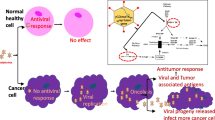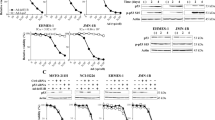Abstract
Background
Malignant pleural mesothelioma (MPM) treated with radiotherapy (RT) has incomplete responses as a result of radiation-induced tumoral stress response that repairs DNA damage. Such stress response is beneficial for oncolytic viral therapy. We hypothesized that a combination of RT and NV1066, an oncolytic herpes virus, might exert an additive or synergistic effect in the treatment of MPM.
Methods
JMN, a MPM cell line, was infected with NV1066 at multiplicities of infection of .05 to .25 in vitro with and without radiation (1 to 5 Gy). Virus replication was determined by plaque assay, cell kill by lactate dehydrogenase assay, and GADD34 (growth arrest and DNA damage repair 34, a DNA damage-repair protein) by real-time reverse transcriptase–polymerase chain reaction and Western blot test. Synergistic cytotoxicity dependence on GADD34 upregulation was confirmed by GADD34 small inhibitory RNA (siRNA).
Results
Synergism was demonstrated between RT and NV1066 across a wide range of doses. As a result of such synergism, a dose-reduction for each agent (up to 5500-fold) can be accomplished over a wide range of therapeutic-effect levels without sacrificing tumor cell kill. This effect is correlated with increased GADD34 expression and inhibited by transfection of siRNA directed against GADD34.
Conclusions
RT can be combined with oncolytic herpes simplex virus therapy in the treatment of malignant pleural mesothelioma to achieve synergistic efficacy while minimizing dosage and toxicity.










Similar content being viewed by others
References
Rusch V, Saltz L, Venkatraman E, et al. A phase II trial of pleurectomy/decortication followed by intrapleural and systemic chemotherapy for malignant pleural mesothelioma. J Clin Oncol 1994;12:1156–63
Price B. Analysis of current trends in United States mesothelioma incidence. Am J Epidemiol 1997;145:211–8
Antman KH. Natural history and epidemiology of malignant mesothelioma. Chest 1993;103(4 Suppl):373S–6S
Takahashi K. Emerging health effects of asbestos in Asia. Presented at: Global Asbestos Congress, November 21, 2004. Tokyo, Japan
Connelly RR, Spirtas R, Myers MH, Percy CL, Fraumeni JF Jr. Demographic patterns for mesothelioma in the United States. J Natl Cancer Inst 1987;78:1053–60
Walker AM, Loughlin JE, Friedlander ER, Rothman KJ, Dreyer NA. Projections of asbestos-related disease 1980–2009. J Occup Med 1983;25:409–25
Kukreja J, Jaklitsch MT, Wiener DC, Sugarbaker DJ, Burgers S, Baas P. Malignant pleural mesothelioma: overview of the North American and European experience. Thorac Surg Clin 2004;14:435–45
Rusch VW, Rosenzweig K, Venkatraman E, et al. A phase II trial of surgical resection and adjuvant high-dose hemithoracic radiation for malignant pleural mesothelioma. J Thorac Cardiovasc Surg 2001;122:788–95
Baldini EH, Recht A, Strauss GM, et al. Patterns of failure after trimodality therapy for malignant pleural mesothelioma. Ann Thorac Surg 1997;63:334–8
de Graaf-Strukowska L, van der Zee J, van Putten W, Senan S. Factors influencing the outcome of radiotherapy in malignant mesothelioma of the pleura—a single-institution experience with 189 patients. Int J Radiat Oncol Biol Phys 1999;43:511–6
Ebright MI, Zager JS, Malhotra S, et al. Replication-competent herpes virus NV1020 as direct treatment of pleural cancer in a rat model. J Thorac Cardiovasc Surg 2002;124:123–9
Stanziale SF, Petrowsky H, Adusumilli PS, Ben Porat L, Gonen M, Fong Y. Infection with oncolytic herpes simplex virus-1 induces apoptosis in neighboring human cancer cells: a potential target to increase anticancer activity. Clin Cancer Res 2004;10:3225–32
Adusumilli PS, Stiles BM, Chan MK, et al. Radiation therapy potentiates effective oncolytic viral therapy in the treatment of lung cancer. Ann Thorac Surg 2005;80:409–16
Eisenberg DP, Adusumilli PS, Hendershott KJ, et al. 5-Fluorouracil and gemcitabine potentiate the efficacy of oncolytic herpes viral gene therapy in the treatment of pancreatic cancer. J Gastrointest Surg 2005;9:1068–79
Adusumilli PS, Chan MK, Chun YS, et al. Cisplatin-induced GADD34 upregulation potentiates oncolytic viral therapy in the treatment of malignant pleural mesothelioma. Cancer Biol Ther 2006;5:48–53
Adusumilli PS, Stiles BM, Chan MK, et al. Real-time diagnostic imaging of tumors and metastases by use of a replication-competent herpes vector to facilitate minimally-invasive oncological surgery. FASEB J 2006;20:726–8
Kim SH, Wong RJ, Kooby DA, et al. Combination of mutated herpes simplex virus type 1 (G207 virus) with radiation for the treatment of squamous cell carcinoma of the head and neck. Eur J Cancer 2005;41:313–22
Wong RJ, Joe JK, Kim SH, Shah JP, Horsburgh B, Fong Y. Oncolytic herpesvirus effectively treats murine squamous cell carcinoma and spreads by natural lymphatics to treat sites of lymphatic metastases. Hum Gene Ther 2002;13:1213–23
Sterman DH, Kaiser LR, Albelda SM. Gene therapy for malignant pleural mesothelioma. Hematol Oncol Clin North Am 1998;12:553–68
Adusumilli PS, Stiles BM, Chan MK, et al. Imaging and therapy of malignant pleural mesothelioma using replication-competent herpes simplex viruses. J Gene Med 2006;8:603–15
Advani SJ, Sibley GS, Song PY, et al. Enhancement of replication of genetically engineered herpes simplex viruses by ionizing radiation: a new paradigm for destruction of therapeutically intractable tumors. Gene Ther 1998;5:160–5
Chung SM, Advani SJ, Bradley JD, et al. The use of a genetically engineered herpes simplex virus (R7020) with ionizing radiation for experimental hepatoma. Gene Ther 2002;9:75–80
Mezhir JJ, Advani SJ, Smith KD, et al. Ionizing radiation activates late herpes simplex virus 1 promoters via the p38 pathway in tumors treated with oncolytic viruses. Cancer Res 2005;65:9479–84
Stanziale SF, Petrowsky H, Joe JK, et al. Ionizing radiation potentiates the antitumor efficacy of oncolytic herpes simplex virus G207 by upregulating ribonucleotide reductase. Surgery 2002;132:353–9
Hollander MC, Zhan Q, Bae I, Fornace AJ Jr. Mammalian GADD34, an apoptosis- and DNA damage-inducible gene. J Biol Chem 1997;272:13731–7
Chou J, Roizman B. Herpes simplex virus 1 gamma34.5 gene function, which blocks the host response to infection, maps in the homologous domain of the genes expressed during growth arrest and DNA damage. Proc Natl Acad Sci USA 1994;91:5247–51
Jarnagin WR, Zager JS, Hezel M, et al. Treatment of cholangiocarcinoma with oncolytic herpes simplex virus combined with external beam radiation therapy. Cancer Gene Ther 2006;13:326–34
Chou TC, Talalay P. Quantitative analysis of dose-effect relationships: The combined effects of multiple drugs or enzyme inhibitors. Adv Enz Regul 1984;22:27–55
The siRNA user guide. Revised May 6, 2004. Rockefeller University, New York. Available at: http://www.rockefeller.edu/labheads/tuschl/sirna.html. Accessed September 3, 2006
Ahamad A, Stevens CW, Smythe WR, et al. Intensity-modulated radiation therapy: a novel approach to the management of malignant pleural mesothelioma. Int J Radiat Oncol Biol Phys 2003;55:768–75
Forster KM, Smythe WR, Starkschall G, et al. Intensity-modulated radiotherapy following extrapleural pneumonectomy for the treatment of malignant mesothelioma: clinical implementation. Int J Radiat Oncol Biol Phys 2003;55:606–16
Sugarbaker DJ, Garcia JP, Richards WG, et al. Extrapleural pneumonectomy in the multimodality therapy of malignant pleural mesothelioma: results in 120 consecutive patients. Ann Surg 1996;224:288–94
Senan S. Indications and limitations of radiotherapy in malignant pleural mesothelioma. Curr Opin Oncol 2003;15:144–7
Zellos LS, Sugarbaker DJ. Multimodality treatment of diffuse malignant pleural mesothelioma. Semin Oncol 2002;29:41–50
Rusch VW, Venkatraman ES. Important prognostic factors in patients with malignant pleural mesothelioma, managed surgically. Ann Thorac Surg 1999;68:1799–804
Bennett JJ, Adusumilli P, Petrowsky H, et al. Up-regulation of GADD34 mediates the synergistic anticancer activity of mitomycin C and a gamma134.5 deleted oncolytic herpes virus (G207). FASEB J 2004;18:1001–3
Advani SJ, Chung SM, Yan SY, et al. Replication-competent, nonneuroinvasive genetically engineered herpes virus is highly effective in the treatment of therapy-resistant experimental human tumors. Cancer Res 1999;59:2055–8
Aghi M, Rabkin S, Martuza RL. Effect of chemotherapy-induced DNA repair on oncolytic herpes simplex viral replication. J Natl Cancer Inst 2006;98:38–50
Curiel DT, Zhu ZB. Combining chemotherapy with virotherapy: a novel treatment strategy for malignant pleural mesothelioma. Cancer Biol Ther 2006;5:236–7
Elshami AA, Kucharczuk JC, Zhang HB, et al. Treatment of pleural mesothelioma in an immunocompetent rat model utilizing adenoviral transfer of the herpes simplex virus thymidine kinase gene. Hum Gene Ther 1996;7:141–8
Gridley DS, Slater JM. Combining gene therapy and radiation against cancer. Curr Gene Ther 2004;4:231–48
Chmura SJ, Advani SJ, Kufe DW, Weichselbaum RR. Strategies for enhancing viral-based gene therapy using ionizing radiation. Radiat Oncol Investig 1999;7:261–9
Luo X, Andres ML, Timiryasova TM, Fodor I, Slater JM, Gridley DS. Radiation-enhanced endostatin gene expression and effects of combination treatment. Technol Cancer Res Treat 2005;4:193–202
Hollander MC, Poola-Kella S, Fornace AJ Jr. Gadd34 functional domains involved in growth suppression and apoptosis. Oncogene 2003;22:3827–32
Hollander MC, Sheikh MS, Yu K, et al. Activation of Gadd34 by diverse apoptotic signals and suppression of its growth inhibitory effects by apoptotic inhibitors. Int J Cancer 2001;96:22–31
Kramm CM, Chase M, Herrlinger U, et al. Therapeutic efficiency and safety of a second-generation replication-conditional HSV1 vector for brain tumor gene therapy. Hum Gene Ther 1997;8:2057–68
Chung RY, Saeki Y, Chiocca EA. B-myb promoter retargeting of herpes simplex virus gamma34.5 gene-mediated virulence toward tumor and cycling cells. J Virol 1999;73:7556–64
Chou J, Chou TC. Quantitation of synergism and antagonism of two or more drugs by computerized analysis. In: Chou TC, Rideout DC, eds. Synergism and Antagonism in Chemotherapy. San Diego: Academic Press, 1991: pp 223–44
Rosenzweig KE, Fox JL, Zelefsky MJ, Raben A, Harrison LB, Rusch VW. A pilot trial of high-dose-rate intraoperative radiation therapy for malignant pleural mesothelioma. Brachytherapy 2005;4:30–3
Yajnik S, Rosenzweig KE, Mychalczak B, et al. Hemithoracic radiation after extrapleural pneumonectomy for malignant pleural mesothelioma. Int J Radiat Oncol Biol Phys 2003;56:1319–26
Hakkinen AM, Laasonen A, Linnainmaa K, Mattson K, Pyrhonen S. Radiosensitivity of mesothelioma cell lines. Acta Oncol 1996;35:451–6
Curran D, Sahmoud T, Therasse P, van MJ, Postmus PE, Giaccone G. Prognostic factors in patients with pleural mesothelioma: the European Organization for Research and Treatment of Cancer Experience. J Clin Oncol 1998;16:145–52
Lilley CE, Carson CT, Muotri AR, Gage FH, Weitzman MD. DNA repair proteins affect the lifecycle of herpes simplex virus 1. Proc Natl Acad Sci USA 2005;102:5844–9
Acknowledgments
Supported in part by AACR-Astra Zeneca Cancer Research and Prevention Foundation Fellowship (P.S.A), grants RO1 CA 75416 and RO1 CA/DK80982 (Y.F.) from the National Institutes of Health, grant MBC-99366 (Y.F.) from the American Cancer Society, grant BC024118 from the U.S. Army (Y.F.), grant IMG0402501 from the Susan G. Komen Breast Cancer Foundation (Y.F. and P.S.A.), grant 032047 from the Flight Attendant Medical Research Institute (Y.F. and P.S.A.), and William H. Goodwin and Alice Goodwin and the Commonwealth Foundation for Cancer Research grant—The Experimental Therapeutics Center of Memorial Sloan-Kettering Cancer Center (Y.F).
The authors thank Medigene, Inc., for providing the NV1066 virus; Liza Marsh of the Department of Surgery at Memorial Sloan-Kettering Cancer Center for editorial assistance; and Yuhong She, MD, and Wong Wai, MS, of the Anti-Tumor Core Facility at Memorial Sloan-Kettering Cancer Center for their assistance with this project.
Author information
Authors and Affiliations
Corresponding author
Rights and permissions
About this article
Cite this article
Adusumilli, P.S., Chan, MK., Hezel, M. et al. Radiation-Induced Cellular DNA Damage Repair Response Enhances Viral Gene Therapy Efficacy in the Treatment of Malignant Pleural Mesothelioma. Ann Surg Oncol 14, 258–269 (2007). https://doi.org/10.1245/s10434-006-9127-4
Received:
Revised:
Accepted:
Published:
Issue Date:
DOI: https://doi.org/10.1245/s10434-006-9127-4




